Game Development Reference
In-Depth Information
effectiveness of the converter engine: The ship's “hyperspeed” range and its capabili-
ties (or cost) to survive a voyage through hostile territories all affect the profitability
of particular trade routes. Eventually, trade routes become less profitable as the play-
er's efforts reduce the demand, and thus the price, for certain goods over time (a
mechanism that is omitted from the diagram).
FIGURe b.4
Travel and trade
in
Elite
The player's location on Planet A or Planet B activates the converters that imple-
ment the trading mechanisms in the center. A few possible ship upgrades are
included on the right.
A converter engine is at the heart of
Power Grid
(
Figure B.5
), although one of the
converters is replaced by a more elaborate structure (see the section “Elaboration
and Nesting Patterns” in Chapter 7, “Design Patterns”). The players spend money
to buy fuel from a market and use that fuel to generate money in power plants.
The fiction of the game is that players generate and sell electricity. However, the
game mechanics do not model electricity itself; players simply convert fuel directly
into money. Surplus money is invested in more efficient power plants and con-
necting more cities to the player's power network. The converter engine is limited:
The player can earn money only for every connected city, which effectively caps
the money output during a turn.
Power Grid
also has a weak
static engine
to prevent
deadlocks: The player will collect a small amount of money during a turn even if
the player failed to generate money through power plants. The converter engine of
Power Grid
is slightly unpredictable as players can drive up the price of fuel by stock-
piling it, which acts as a
stopping mechanism
at the same time.




